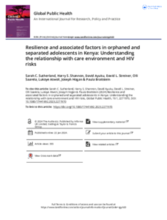Orphans are at higher risk of HIV infection and several important HIV risk factors than non-orphans; however, this may be due to a combination of related social, psychological, and economic factors, as well as care environment, rather than orphan status alone. Understanding these complex relationships may aid policy makers in supporting evidence-based, cost-effective programming for this vulnerable population.
This longitudinal study uses a causal effect model to examine, through decomposition, the relationship between care environment and HIV risk factors in orphaned and separated adolescents and youths (OSAY) in Uasin Gishu County, Kenya; considering resilience, social, peer, or family support, volunteering, or having one’s material needs met as potential mediators. The authors analysed survey responses from 1105 OSAY age 10–26 living in Charitable Children’s Institutions (CCI) (orphanages) and family-based care settings (FBS). Follow-up time was 7–36 months.
Care in CCIs (vs. FBS) was associated with a decreased likelihood of engaging in forced, exchange, and consensual sex. Excess relative risks (ERR) attributable to the indirect pathway, mediation, or interaction were not significant in any model. Care environment was not statistically associated with differences in substance use. The authors' findings support the direct, unmediated, association between institutional care and HIV risk factors.

